Intermittent Fault Detector™ (IFD-256™) Test Summary
Introduction:
The subject harness provided by Dassault was provided to the Universal Synaptics (USC) / Barfield, Inc. team on site at the Dassault St. Cloud facility in France. Testing was conducted to demonstrate Intermittent Fault Detection™ (IFD™) technology and was coordinated by Barfield and Dassault.
Selection of this test harness was made by Dassault personnel due to No Fault Found (NFF) rates and intermittent issues on aircraft entertainment systems. Note that the harness tested is not an on-board wiring system, rather the test harness utilized to connect to the system for testing the on-board entertainment system wiring when issues arise. The USC / Barfield team recommended testing the actual troublesome entertainment wiring system on the aircraft. This particular test procedure allows for verification that the test harness is intermittent free.
Testing was conducted to demonstrate the advanced prognostic / diagnostic capability of IFD technology. USC and Barfield arrived with the portable IFD test set and the HDMI Quadrax Interface Test Adapter (ITA) that was designed, developed, and manufactured by Universal Synaptics. No Test Program Set (TPS) was developed or required prior to arrival, due to the PIFD’s AutoMap™ capability.
Test Procedures:
- AutoMap™ – discovered the Unit Under Test (UUT) true as-wired configuration
- Subject test harness was used as a baseline “gold” unit to establish UUT profile
- Continuity – tested for open circuits and measures resistance against established AutoMap baseline (open circuits / high resistance tests)
- Shorts – provided shorts indication and shorts tracing
- Intermittence – monitored all circuits to detect and isolate all three Stages of intermittent faults (see Graphic 1)
- Fault Isolation – detected intermittent faults through programmatic isolation
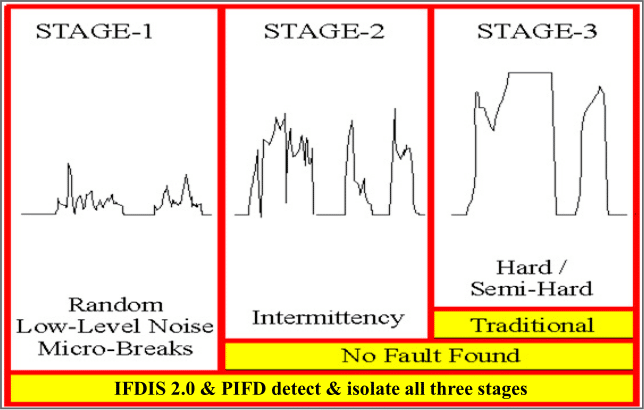
Graphic 1 – Three Stages of an Intermittent Fault
Stage 1 – random low-level nanosecond microbreaks, likely not operationally evident yet, but on curve of degradation to become Stage 2
Stage 2 – intermittent failure evident to pilot in operation, reported to ground crew, passes ground test and labeled No Trouble Found (NTF) or No Fault Found (NFF), on curve of degradation to become Stage 3
Stage 3 – semi-hard or hard failures, Automatic Test Equipment (ATE) and troubleshooting tools such as DMMs designed to detect hard faults (open circuits or shorted circuits)
Results:
HDMI Quadrax Test Harness
Test Date: 11 March 2020
Connecting to the UUT:
- USC Technical Director had difficulty connecting the ITA to connector shown in Graphic 2. Dassault technician attempted to fix the issue by pushing out the tab within the sleeve with tool as shown in Graphic 3. USC Technical Director indicated this issue as a potential intermittent failure area due to bent/pushed connection points within the connector.
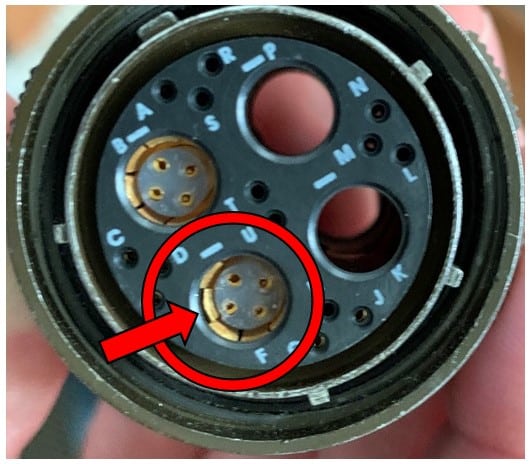
Graphic 2 – Potential Trouble Area for Intermittence
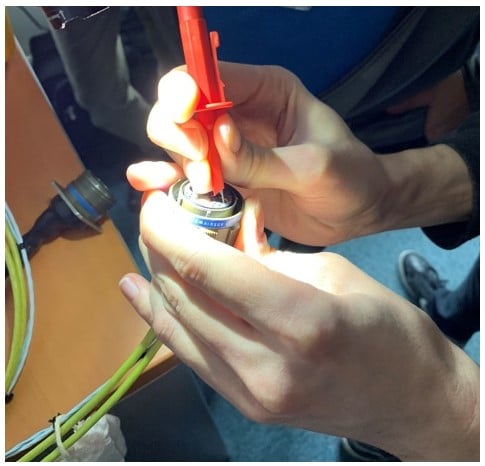
Graphic 3 – Technician Manually Fixing Connector
- Connector securely seated after corrective action; red indicator line not showing, thus indicating proper mating; seemed to have issues with over-torquing
- It was also explained that to properly verify ITA fabrication, a “gold” UUT is leveraged to run intermittence testing with IFD technology, thus ensuring there are no intermittent faults in the interface harness itself. Since USC did not have a UUT, on-site verification of the fabricated harness took place.
Test Procedures:
- AutoMap – HDMI Quadrax Test Harness true as-wired configuration recorded and saved
- IFD-256 Continuity testing conducted – no open circuits present in the UUT
- IFD-256 Shorts testing conducted – no shorted circuits present in the UUT
- IFD-256 Intermittence testing conducted – multiple intermittent events (8 discrete intermittent events) detected on D-Sub 15, Test Point (TP) 63, Node 4 with light, manual manipulation of the harness around the bottom of the connector (see Graphic 4). The connector was tightened and loosened to verify if there were potential pushed pins. The trouble area during ITA connection to the UUT seemed to be the area where these intermittent events were occurring during intermittence testing. D-Sub 16, TP 64, Node 1 also indicated one intermittent event and was more than likely associated with the same intermittent connector.
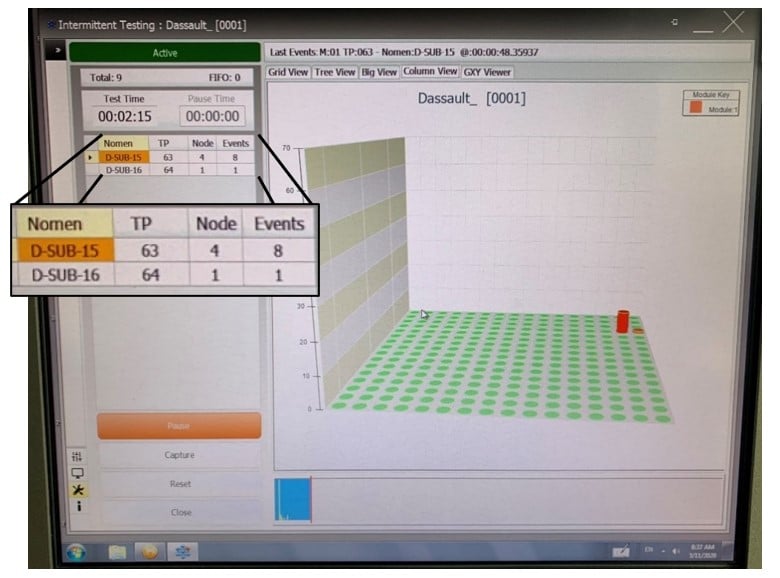
Graphic 4 – Intermittent Graphic – HDMI Quadrax Test Harness
- Connectors were disconnected and reconnected to ensure both canon connectors were properly seated past the red indicator line. This was done for reverification of connection to ensure proper seating to all TPs of the UUT.
- IFD-256 Intermittence testing was conducted again with multiple intermittent events (13 intermittent events) detected again on D-Sub 15, Test Point (TP) 63, Node 4 with light, manual manipulation of the harness around the bottom of the connector (see Graphic 5). The connector was again tightened and slightly loosened to verify if there were potential pushed pins. Again, the trouble area during ITA connection to the UUT seemed to be the area where these intermittent events were occurring. D-Sub 16, TP 64, Node 1 also indicated intermittent events again (5 intermittent events) as well as D-Sub 28, TP 75, Node 3 showing 3 intermittent events. Intermittent events continued to manifest with tightening of that cannon connector and loosening back to proper red indicator line.
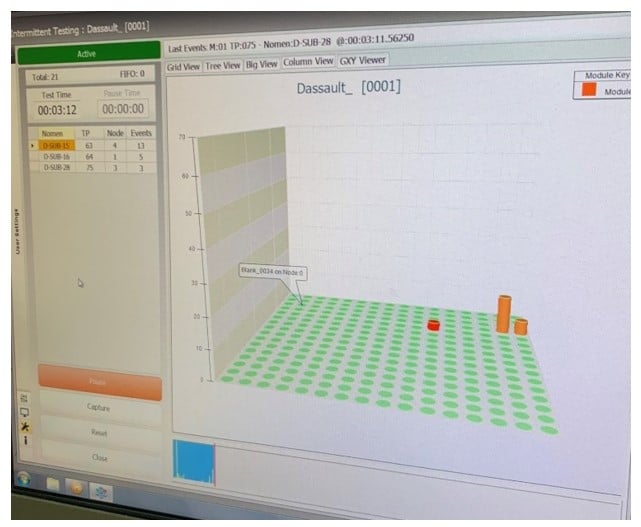
Graphic 5 – Intermittent Graphic – HDMI Quadrax Test Harness Retest
Recommendation:
- Utilize intermittent fault data provided from the IFD to visually take the detected and isolated intermittent failures to root cause. Attention should be given to the potential area of pushed pins on the trouble connector. Initial visual inspection of the trouble area seemed to indicate that the pin area was lower than the other mating connector pin area, thus tying back to the over-torquing potential issue of the initial trouble connector.
- Insert portable IFD testing into the Dassault Fault Isolation Manual (FIM) and/or CMM to reduce NFF occurrences due to undetected and hence unrepaired intermittent faults – this potential pushed pin / over-torquing issue would manifest on the aircraft side of the test harness that showed this problem.
Observations:
- Conventional ATE / troubleshooting tools and techniques are severely limited and did not find these intermittent faults (see Graphic 1 – Three Stages of an Intermittent Fault)
- The portable IFD test deemed this harness to be unserviceable that requires a repair action before release to use as a test harness
- When the actual HDMI Quadrax wiring system fails in operation and returns to the repair facility, it will likely continue to test No Fault Found (NFF) with current FIM / CMM testing procedures and conventional troubleshooting tools
Summary:
Universal Synaptics’ patented Intermittent Fault Detection (IFD) technology has proven to increase aircraft component reliability. As proven by this demonstration, IFD technology, once implemented, will increase the reliability of the aircraft by ensuring that open circuits, shorted circuits, and intermittent circuits are not present in the wire bundle assemblies / wiring systems flown and maintained by Dassault.
The ability to detect and isolate intermittent faults in wiring harnesses and components, thus preventing Operational Difficulty Index (ODI) events and customer dissatisfaction, will save Dassault on unnecessary expenses associated with NFF. The Air Transport Association (ATA) estimates that NFF costs the commercial aviation industry $250,000 per year per aircraft. Testing wiring harnesses and components in accordance with the FIM and/or CMM designates them “serviceable” from a requirement perspective but does not solve the issues lurking beneath the surface that conventional test equipment and troubleshooting methodologies cannot detect and isolate.
